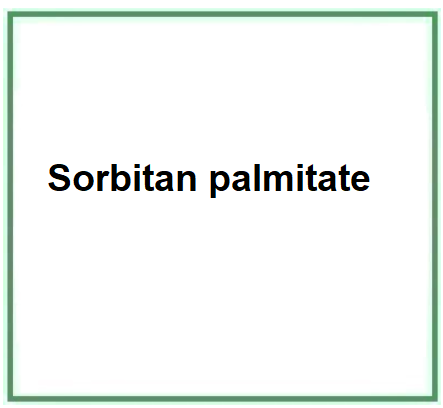Sorbitan monopalmitate is a chemical compound, The monoester of palmitic acid and hexitol anhydrides obtained from sorbitol.
The name describes the structure of the molecule:
- Sorbitan refers to sorbitan, a derivative of the alcohol sorbitol. Sorbitan is obtained by dehydrating sorbitol and is known for its ability to stabilize emulsions.
- Monopalmitate indicates that sorbitan is esterified with palmitic acid, a type of fatty acid. The addition of palmitic acid to sorbitan creates an effective emulsifying agent.
Raw Materials and Their Functions
Sorbitol. A sugar alcohol derived from natural sources such as fruits and corn. It is used as the base for producing sorbitan through dehydration processes.
Palmitic Acid. A saturated fatty acid commonly obtained from natural oils and fats. It is used to esterify sorbitan to form sorbitan monopalmitate.
Industrial Chemical Synthesis of Sorbitan Monopalmitate
- Dehydration of Sorbitol. Sorbitol is dehydrated to form sorbitan, a molecule with a five-membered ring.
- Esterification. Sorbitan is then reacted with palmitic acid to form sorbitan monopalmitate. This process involves forming an ester bond between sorbitan and palmitic acid.
- Purification. After the esterification reaction, sorbitan monopalmitate is purified to remove impurities and by-products.
- Quality Control and Packaging. The purified sorbitan monopalmitate undergoes quality checks to ensure it meets the required standards. After quality control, it is packaged for use as an emulsifier and stabilizer in cosmetic, pharmaceutical, and food products.
Form and Color
Typically appears as a solid or semi-solid wax, white or light yellow in color.

What it is used for and where
Cosmetics
Surfactant - Emulsifying agent. Emulsions are thermodynamically unstable. Emulsifiers have the property to reduce the oil/water or water/oil interfacial tension, improve emulsion stability and also directly influence the stability, sensory properties and surface tension of sunscreens by modulating their filmometric performance.
CAS: 26266-57-9. 5050-91-9
Food
Ingredient included in the list of European food additives as E495 with an emulsifying function.
Commercial applications:
Cosmetic and Food Industry. Sorbitan monopalmitate is commonly used as an emulsifier in cosmetic and food products. It helps to mix water-based ingredients with oil-based ones.
Skin Care Products. Found in creams, lotions, and other skincare products, where it contributes to maintaining the homogeneity of the formula.
Food Products. Used in some food items, like cakes and baked goods, to improve texture and extend freshness.
The Panel on Food Additives and Nutrient Sources Added to Food (ANS) has provided a scientific opinion re-evaluating the safety of sorbitan monostearate (E 491) when used as a food additive. The experts gave sorbitan monostearate (E 491) an ADI (Acceptable Daily Intake) of 26 mg/kg body weight per day (1).
References________________________________________________________________________
(1) EFSA Panel on Food Additives and Nutrient Sources added to Food (ANS); Mortensen A, Aguilar F, Crebelli R, Di Domenico A, Dusemund B, Frutos MJ, Galtier P, Gott D, Gundert-Remy U, Leblanc JC, Lindtner O, Moldeus P, Mosesso P, Parent-Massin D, Oskarsson A, Stankovic I, Waalkens-Berendsen I, Woutersen RA, Wright M, Younes M, Boon P, Chrysafidis D, Gürtler R, Tobback P, Altieri A, Rincon AM, Lambré C. Re-evaluation of sorbitan monostearate (E 491), sorbitan tristearate (E 492), sorbitan monolaurate (E 493), sorbitan monooleate (E 494) and sorbitan monopalmitate (E 495) when used as food additives. EFSA J. 2017 May 5;15(5):e04788. doi: 10.2903/j.efsa.2017.4788. PMID: 32625491; PMCID: PMC7010202.
![]() Sorbitan monopalmitate
Sorbitan monopalmitate 


